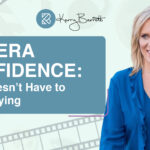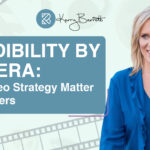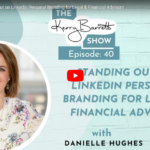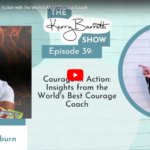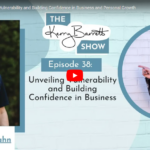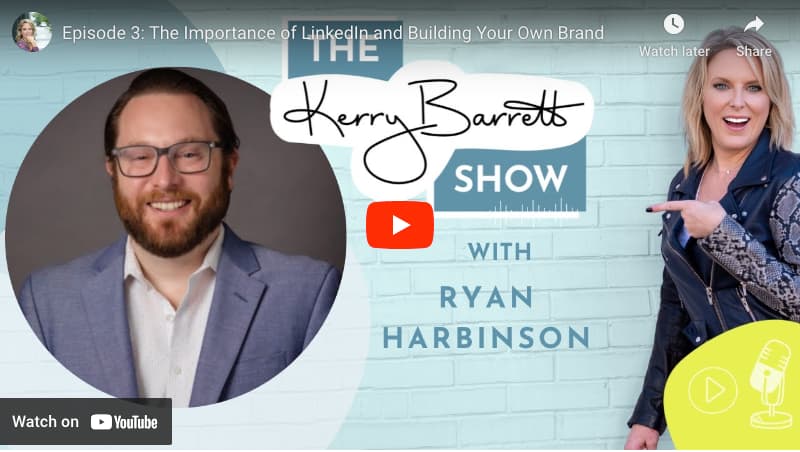
In this week’s episode of the Kerry Barrett Show, we’ve got an incredible guest, Ryan Harbison, who’s a true expert in personal branding and messaging! Ryan’s gonna reveal some game-changing strategies on how to effectively leverage your personal brand to create messages that truly connect with your audience. Discover the ins and outs of LinkedIn as he also introduces the Dollar 80 strategy, a clever approach to connecting with relevant individuals within your industry. Learn how to make the most of it to expand your network and establish meaningful connections. Get ready to rock your brand! Grab your headphones, tune in now.
Transcript
Kerry Barrett 15:05:22
Welcome to the Kerry Barrett show. I’m Kerry Barrett.
Along with expert interviews about social media about video marketing and about video strategy, this podcast is the place that you’ll come to learn to show up comfortably, confidently and compellingly on camera so that you can leverage the lens for every single opportunity it can give you. That means social media means content creation, it means media opportunities, course creation and audience visibility and growth. I overcame a debilitating fear of speaking to go on to a 25 year Emmy award winning on camera career. But it’s only when I realized the connection wasn’t about perfection, but about realness and relatability that my success on camera and in my business soared. It’s how I grew my brand, online and in life. And this is where you will learn to do the same. So let’s jump in.
Thank you for joining us for this episode of the Kerry Barrett show. Our guest expert today is Ryan Harbison. How are you?
Ryan Harbison 15:06:39
I’m good. Thanks for having me.
Kerry Barrett 15:06:42
If you don’t know Ryan, he is a personal branding expert. He is a messaging expert. He also works for a corporation and understands the importance of having a brand sort of beyond the four walls of your business. But I won’t put words into your mouth. Ryan, why don’t you introduce yourself to the audience?
Ryan Harbison 15:07:01
Sure. Thanks so much. So I am with Robert Half, I’m out of the Philadelphia office, we are a global company fortune 500. You know, my background is a little different, though. I mean, I’m a tech, marketing and branding guy. For the majority of my career, I was a video game developer for a long time, ran my software business with a couple of my friends and, you know, did a lot of the branding, and creating, you know, personal brands for our business. And then for myself as well transitioned into the the print design, and then into the full on agency branding department of the world and kind of just always been in that tech and branding space for many years
Kerry Barrett 15:07:42
when and one of the things that you mentioned as it pertains to that, which is, you know, part of what you do now, and certainly part of what you did in the past is understanding who it is you’re talking to whether you’re looking for your next opportunity, whether you’re bringing somebody to you or whether you are going out and creating something on your own. So let’s start understanding how to use your brand and craft your message and bring it all together. Like
Ryan Harbison 15:08:07
it’s really two sides of the same coin, the personal brand element of yourself when you’re working for someone is just kind of a plus on getting the messaging out there. So I think that people get lost in the art of social sandwich. So we’re seeing a mass exodus off of Instagram right now, because 50% of the platform is people just trying to sell stuff. I mean, we’ve got 24% of followers between 10,000 and 100,000. And then 26% have between 100,000 and a million and a large percentage of that 50% are all affiliate people that are pushing some kind of product. I mean, scroll through your Instagram now it’s like three to maybe four, and then you’re gonna get a sponsored ad. I mean, and then there’s banners everywhere. I mean, it’s getting out of control. So it’s understanding where your audience lives, the way that we look at it is, who is your messaging going to? How can you utilize your personal brand with your personal contacts? And what platform stories are you telling based on who is on there, say that I go to a restaurant and I know the owners, my story is going to be different on different platforms based on who my audience is interests Facebook, I’m going to take a selfie with all my friends at the team on Instagram, I’m going to take a picture of my food LinkedIn, I’m going to take a picture with the owner. The twist on that is that when my personal brand is integrated into that it helps bring awareness to people that have already been following me before I started working for the organization that I’m with.
Kerry Barrett 15:09:36
How do you figure out right, your example was very clear. But when it comes to crafting what goes beyond that visual or understanding the language? For example? How do you really start with that?
Ryan Harbison 15:09:52
Yeah, I mean, I think part of it is picking one platform, honestly, because it’s overwhelming between Facebook and Instagram and Tiktok and YouTube and Twitter and the list goes on and on and on. And threads and oh my god, it’s endless. It’s a full time job. I mean, Twitter alone is just a full time job because basically, you’re just text messaging with everybody in the world every day. Like that’s really what it comes down to. So I think first of all is understanding where you want to live on the platforms and that is the hardest part, because then we’ll get integrated into what is the type of content that you’re putting out. And I think people get especially right where a lot of the audience probably is that it all has to be business content. And I think that is one of the key things that I push out all the time is that LinkedIn is social media, you just have to know where it’s like you can have fun on LinkedIn, it doesn’t just have to be like, buy my book, every post, right? Because no one’s going to respond to that, that doesn’t work. It does not work. I mean, we talked about this before, there’s a big difference between educating people on what you do and hard selling to people, you talk to mind, you know, first to mind live in the feed, that’s a big part of it low and slow patients over greed. That’s how it works. It takes time for this stuff to grow. So I think part of it is understanding what platform you want to be. So LinkedIn is a different story. So what we want to do on LinkedIn is we want to do a couple things like I’m a big, I have a big part of my LinkedIn presence is I like people to know who I am. And my personality. So like, everyone has like 10 websites that they start their morning on. Now, those websites are content that you can put out online, it doesn’t necessarily just have to be integrated into the industry that you’re in, right? Like I came from the video game industry, I still play games, a lot of my content is based on tech and games. And that’s just what I like. But now I’m also putting that out there. And then using the companies and the corporations that I’m with, to kind of tell a story based on the, on the industries that I’m trying to get in front of. So I’m not always pushing out, you know, the corporate content, but I’m putting it to the audience that I’m trying to bring into me to check out my profile to understand what I do and then leaving in the comments. I mean, we’ll talk about this later. But I mean, if you’re not living in the comments right now, on any of the platforms, you’re missing out on people discovering
Kerry Barrett 15:12:12
what I do quite so let’s actually jump into that right now. Because I do think a lot of people think that the hard work is the post and yes, that is difficult sometimes to come up with content ideas, and certainly it takes a little bit of research to understand what resonates with your audience and you’re right it is not by my book that’s not up a funnel type of stuff. We’re talking about awareness but the comments is where the the actual gold is my in your mind why commenting the actual work part of establishing a brand so social media, LinkedIn or otherwise,
Ryan Harbison 15:12:51
Let’s start about the analysis by paralysis by content and then move into the comments right so content is king engagement is queen. Okay? So the way I look at it is that this content is only as crazy as you want to live in your brain about it right? You don’t have to create full blown influencer videos online every day trying to come up with new things that people aren’t doing. You know, there is an amazing thing. If you look at the original beginnings of Barstool Sports on Instagram. How did they become super popular? They just shared everybody’s stuff. Yeah. utilize other people’s content as your own. Okay, nothing that’s original anymore anyway. No, there are people out there that have teams that spend millions, the Gary V’s of the world, all the Shark Tank people, you know, Simon say like all these people, they want you to share their stuff. Yeah. So there’s nothing wrong with your content, just being you know, the kind of you kind of like our go to for a certain sliver of influencer content. Yes, that you can’t exactly go into syndication with this stuff. And you’re putting your own little bit in. So I always say, Don’t do a blind shares. So when you share it out, write a little three or four sentence blurb overtop of how it is relevant to you and your situation. Okay. And the other side of the coin is comics, right? You have to live in the comments. And I’ll tell you why. People discover you and get to know your personality better when you’re living in the comments, right? If you can live in the comment on the comment on the comment stuff. That’s great. And the best part about comments is that you can comment on anybody’s stuff. You don’t have to be connected to them to comment. And that’s why it’s important for your profiles on any of the platforms to be very well established. Like, you have a great picture, you have a good you know, if I go to your profile, I need to know what you’re doing. Because when we’re in those comments is going to drive people to our pages.
Kerry Barrett 15:14:56
Yeah, that profile needs to almost serve as like a little mini landing page, if you will.
Ryan Harbison 15:15:03
Yeah, it’s like a hub for everything that you’ve got going on. And here’s the best part is that you can have great conversations in the comments, especially like if you have like people that are doing things with so prime example like, once this goes online, like and you’re posting it like you and I are gonna dominate the comments on everybody’s comments, and we’re gonna comment on it. everybody’s comments and we’re gonna comment together. Because what that does is it allows us to be pushed up in the algorithm for free, right? So we’re getting all this organic, like eyeballs on all of us, you know, my audience is going to see it, your audience is going to see it, and it’s going to grow. It’s gonna kind of mix our audiences together, which is really what we want. But what’s great now too, is that I’m going to be in the comments, commenting on people’s stuff, I’m going to be checking out their profiles, they’re going to be checking out my profile, we’re going to be able to continue to grow the reach, then when people share that stuff, now we’ve got not only on posting it, you’re posting it, now people are sharing it. So now we’re going on the shares. And we’re commenting on what people share. So now we’re talking to third connections that have zero people involved with us, but now are finding our content or now are coming to our profile all because we’re living in the comments.
Kerry Barrett 15:16:15
I let me just piggyback on that for a second to make this tangible. I’m working with somebody now who I’ve hired for copywriting and some other stuff based on exactly what you’re telling me. I was on LinkedIn looking for somebody who could articulate my message well, to my two different avatars, which has always been a struggle for me. There’s a crossover, but the language is different. And I was trying to streamline that process. And I found somebody who had commented on somebody else’s post who did exactly that. And I followed, and I looked at the profile, and it looked at what he did, and I looked at his content. And then I’m like, I think this is a person I should talk to. And it has had it started with simple messaging on LinkedIn. And now it’s expanded to copywriting for the website, etcetera, etcetera. But my point is what you’re saying is not abstract, it actually works.
Ryan Harbison 15:17:11
Yeah, 100%. And it can be utilized in a couple of different forms. You can also use this in the hashtag game. So certain platforms utilize hashtags better than others. We all know, Facebook is not great with hashtags. LinkedIn has done a great job over the last three years to integrate hashtags into the platform, Instagram and Twitter were built on hashtags. So what’s great about it, it’s the dollar 80 strategy, which is a classic Gary Vee. So it’s 10 Hashtags a day, nine posts under those hashtags, and you’re gonna like, comment and share on those on those actual hashtags. Now, those hashtags can be one of two things, it can be things that you’re interested in, and you’re trying to get involved in a certain community. It can be an audience that you’re trying to, you know, be more involved with, because you have a product that you’re trying to push to them and you’re trying to educate them on the low and slow patients over greed mentality, right? We’re not going to just LinkedIn somebody connect and go, good afternoon, sir. Mattawa has a product that you would love to go by seeing you later. But like, imagine if I find your profile on LinkedIn, because we were in the comments together, I go on your LinkedIn page, I don’t connect with you, I follow you. So now all your content that you like, comment, share appears in my feed as if we were connected, then I go into your activity, and I start liking and commenting, sharing on all your old posts, what happens is that you’re going to come eventually, and check out my profile. And now you can possibly be a client at some point, but it takes time for me to pay this is who I am, this is what I do. And I’m creating opportunity, but living in the comments. Well, I
Kerry Barrett 15:18:46
It’s so smart. And I think a lot of times if you’re not in that sort of like creator or personal brand mindset, you sort of think of LinkedIn, especially as an online resume or an online place to say, you know, Hey, Sally had great success if you want results like Sally, call me like that. That’s not how it works at all.
Ryan Harbison 15:19:11
It was like 15 years ago, yeah. It’s evolved. So
Kerry Barrett 15:19:15
What do you think are the keys then to building that personal brand and finding the right message online? Let’s stick with let’s stick with LinkedIn since we’re headed down that road right now. Anyway, what are the mistakes you see people making when it comes to establishing that brand online and like three key things that they can put into play today to start out?
Ryan Harbison 15:19:33
So I think the first major one too is you can’t force the personal brand to organically be created. The backstory on my personal brand, you know, hashtag where’s our, that was created, because people said that to me all the time. Because I’m, you know, I have many mantras in my life, and one of my ones is everywhere, all the time, always the way that I lead, right? I’m a road warrior. I’ve always had stuff, I’ll do three or four events in a day. And people are like, man, where are you going to be next? You know, where’s Harvard gonna be next? And I was like, hey, that kind of like that. People have been saying that a lot. Right? So you know, thinking about what you’re doing and like what people are saying like they can can really lead to building that brand. I think the other thing is too is your brand, a professional brand, or is it who you are as your personality? Right? And that’s a big difference as Well, right. So and I think
Kerry Barrett 15:20:23
portably? Are the two mutually exclusive? Or is there some cross?
Ryan Harbison 15:20:27
They can definitely blend together, right? But I think you need to establish like, it’s just going to be a business brand. And it’s going to be like, am I gonna be like the guy who cooks in my kitchen every day? And that’s my personal brand? Or am I, you know, a bizdev? guy who is creating awareness of my company, which is what my stuff? That’s right, you know, but my stuff is kind of mixed together now into a kind of a 7030. Kind of pot. Got it? Okay. You know, and I think one of the things that people have problems with is that they hear a personal brand, and they’re already just like, frozen in place. Yeah, right.
Kerry Barrett 15:20:58
Oh, my gosh, do I have to share like, you know, that my kid? I don’t know, had it down today at Target like, that’s?
Ryan Harbison 15:21:06
Yeah. So I think part of it is understanding this is, you know, you need to figure out what, and how you’re going to push that messaging out, right? It is important to create your own hashtags, because then you can filter through your own stuff. But remember, no one’s going to look for your hashtags, you know that that hashtag that’s already, you know, or oriented with your personal brand is going to be just a low and slow build up so people can find it after you kind of establish after you’ve established a connection, right? Okay. Correct. I mean, it took me five years to kind of get my brain on the map. So now, when you look up a hashtag, where’s hard? There’s a bunch of stuff on different platforms. But, you know, in month six, it was just me by myself, but there was nothing else. And now people use, you know, so I think that’s what I think, too, is it’s understanding, again, it sounds a lot of the same stuff, but it’s understanding who the audiences, right, it’s very important to understand what you’re, you know, some brands work better on Facebook, than they do on Instagram than they do on LinkedIn. Right. I think that’s part of it, too. And I think the third thing really, is understanding that it takes time to develop these brands, it takes time to really push them out there. And you really have to establish, you know, why you’re doing. And I think people kind of overlook that. They just want to create a personal brand and go, but like, why are you actually creating this brand? And once you figure out why it’s a thing, then you’ll have more fun with it. It’ll become more organic, and it’ll continue to grow when you’re living in the conference.
Kerry Barrett 15:22:37
Yeah. Let me ask you this. Why why? How do you figure out why? And I know, it sounds very basic. Yeah, no, it’s not, though. It’s not. And I, and there are a lot of products. And there’s a lot of failed businesses out there that will tell you, we didn’t figure out who we were talking to, and why we were talking to them. How do you how do you
Ryan Harbison 15:23:00
figure that out? Yeah. And I think for me, it was an, it was another slow organic thing. I mean, originally, the brand started off because I was doing 80 hours a week, eight days a week for 10 years, right? Then I retired from my gig. And then I went to a 40 hour job week. And now I had all this time. And I was just like, What am I doing, and I kind of just wanted to establish myself, you know, as a presence online to kind of, you know, I’m not trying to be, you know, a global influencer, I’m trying to be a nano influencer, like, I wanted to be relevant in the Philadelphia, South Jersey, Delaware, maybe a little bit of New York area, like, that’s great for me, like, I don’t need any more than that. In order to do that. You need to have people remembering, I mean, that’s really the key to it all. Like, if you’re just insurance person X, or, you know, salesperson y, right, you’re gonna get lost in the shuffle. For me, you know, this is the third iteration of companies that I’ve been with where my brand has followed me with, with me, and people know who I am. So when I changed my banners, and I changed my stuff, my personal branding is still integrating into that as well. So people are now curious about who I am aware of, and what’s going on, you know, so the reason, for me, is really establishing myself to be relevant in the audience in the surroundings of my area that I want to stay, you know, well known. And what’s great about it is that the brain changes over time. So originally, it was just kind of, I’m a designer by trade, right? So I just like to create stuff, and I wanted to make something that was me. And then it kind of turned into like, Oh, this is my I’m at events all the time. And this is just what people say. But now it’s turned into a whole other thing over the last 18 months. And now it’s you know, I do LinkedIn stuff. Like this is really where my passion is. I like to help people grow their stuff organically through LinkedIn, not having to pay any money for anything, right, finding the right people getting in front of the right audiences, you know, integrating the marketing and branding side of LinkedIn. You know, that people, I think, overlook stuff. So now it’s kind of changed and morphs. So you know, it’s all about, we say it all the time, right adapter dies and name of the game. And that’s kind of where it is. So the reason for me is initially to create that awareness. And I think that’s kind of where it starts for everybody, right if you want to create some awareness for yourself, and you want to have fun with your personal brand. And I think what happens is that it becomes stale and dull, or you’re putting out content that nobody’s reacting to, or you’re, you’re losing the audience, then you have to kind of adapt a little bit and change, right? Go back and look at the last six months of the content that you put out and see what’s done very well. And then be like, alright, well, I did this three minute video, it did really well. I said 10 things in that video, I can take those 10 things out, and I can do one video. That’s that same style of video and let’s, let’s mess with this a little bit and see how this does. I think that’s a lot I know, that’s a lot of information. But it’s it’s, it’s not an easy thing. It takes time to develop.
Kerry Barrett 15:26:26
It does, it’s not a quick win. It is.
Ryan Harbison 15:27:41
Feel like you’re kind of in a rut? Like, yeah, it’s okay to ask for help. Yeah, like, reach out to those people or those users and go, Hey, I see that you’re always liking my stuff. Can you just tell me what you love about my content? Yeah. Oh, dude, they’ll be so excited that you’ve reached out to them and asked for their opinion, they’re gonna tell you everything you need to know. So if you?
Kerry Barrett 15:29:19
What is your thought on the demographic for Facebook, you mentioned like if I’m on, you know, if I’m taking I’m at a restaurant and I you know, here’s the three platforms I’m on Facebook is going to be one where I take a picture of my knee and my friends around the table and whatever. Is there. Is there a prime demo for Facebook? Is it older? Is it changing?
Ryan Harbison 15:29:39
What are yours all over the place? Facebook, I mean, Facebook, maybe when Instagram, like when there was that mass exodus off of Facebook onto Instagram. And the younger kids were going over there. And then, you know, all the older Gen X and the baby boomers were kind of hanging out on Facebook. That has really changed. I mean, I know the millennials are living on Facebook right now too. I mean, you know 30% of Facebook traffic is in the marketplace first of all, yeah. So think about that. That’s my marketplace has not been like pulled off of Facebook and made its own app, right? Because you have to go onto Facebook to do it. The other thing that I’ve been seeing that’s really kind of been crazy is that there is this weird line between like LinkedIn And Facebook friends, right? And like your Facebook friends were this and your LinkedIn people were this. Now what I’ve seen over the last like, two years or so three years, is that LinkedIn people that you do business with and all that are now friending you on Facebook? Yes, absolutely. Which is wildness. So there was this weird like, no, it’s we keep it separate. But now everybody is going together. So you can kind of create the same messaging on LinkedIn and Facebook, and get a better response on Facebook with the same people that would most likely like you’re strong on LinkedIn.
Kerry Barrett 15:31:00
I think there’s a sense and maybe again, maybe it’s a little bit dependent upon the age bracket, etcetera. But there is a sense of maybe a little bit more freedom on Facebook, there’s still some stoicism perhaps attached to LinkedIn, Facebook, there is a little more of a the ability to feel a little more free, perhaps with what you post or the things that you say, nevertheless, that personal connection is still a key part of how business is done, and how business connections and networking are established?
Ryan Harbison 15:31:35
Well, I think what we’re seeing is that Facebook is creating a more robust personality of who people are, yeah, on the platform, right. So LinkedIn is fun. And you know, this is who I am. But on Facebook, you know, let’s be honest, well, if I’m on LinkedIn, I don’t want to see your kids’ first day of school. I don’t care, right? I don’t care about how you lean in politics or anything like this. But Facebook is still crazy. So like, remember, like, when you’re friending all these people that are your LinkedIn connections, you got to kind of monitor what you’re saying, on Facebook, because you might lose business. That’s the slippery slope that we’re on now. But, you know, I see posts of people that will post the same thing on Facebook, and the same thing on LinkedIn. LinkedIn does very well. And Facebook does great, because there’s just more interaction on Facebook, right? LinkedIn is more of a nine to five thing. Facebook is just flipping on for a minute, or a minute and a half and running through it. People are also learning that you can unfollow people on Facebook now more than ever, so people’s feeds are more precise on what they want to see. And curate it exactly. You know, I never really unfriend people, I just kind of unfollow people, because I want that messaging that I’m putting out on Facebook to be seen by all those people. Right? It’s just more people to see. And that’s really what it comes down to. But there is this weird thing where the business community is friending each other on Facebook, and it is wild, it is very wild. People that I’m kind of just like acquaintances with that I see it like random, like, events are now like, Oh, should we preach book friends and
Kerry Barrett 15:33:21
Facebook was dead.
Ryan Harbison 15:33:23
It’s not Facebook is not dead. I mean, it’s not, it’s clunky, but it’s not dead. You know,
Kerry Barrett 15:33:28
it’s gonna be around for a while and bury it and meta, et cetera, et cetera.
Ryan Harbison 15:33:34
I mean, it’s, it’s crazy to I mean, like part of it, I think what people don’t realize is that that Facebook group that you like, or that Facebook like network that you have, you know, there’s a lot of opportunities for you to shine your personal brand within those right, especially when you’re trying to get into certain stuff. So in my space, we’re accounting and finance, right. So like, I’m placing people in jobs, and working with companies that are looking for accounting, finance positions, I can go on Facebook, and there are the Philadelphia accountants and finance group. So I can join that group on Facebook, and live in that and then go back to what we were talking about before, live in the comments, go through this. And then work the opposite side of the rail, where I’m going to find out the people that are relevant, maybe that are CFOs, or controllers and companies, and then find them like, comment and share all their stuff and like and maybe have a conversation with them on Facebook, and then go to LinkedIn and friend them on LinkedIn. Which I think are opportunities that people are missing out on, right, is that cross contamination is coming one way but it can also go the other way as well.
Kerry Barrett 15:34:34
Yeah, yeah. That other side of this is the same coin. The flip side is Don’t sleep
Ryan Harbison 15:34:39
on the Facebook groups because the audience that you’re trying to get in front of, there’s probably a group for it.
Kerry Barrett 15:34:45
Oh, get search search groups and Facebook and I guarantee no matter what niche you are, you’ll find a spot
Ryan Harbison 15:34:53
doesn’t matter.
Kerry Barrett 15:34:55
Well, Ryan, it’s been awesome talking with you tons of information about the different platforms, how to establish branding, how to figure out who your audience is and how to talk to them. Where should people find you if they’re interested in working with you if they’re interested in finding out more about your business? Is there a freebie or an offer or something that you want to give people?
Ryan Harbison 15:35:19
Yeah, sure. So the best place to find me is Can we connect on LinkedIn? Just Ryan Harbinson on LinkedIn, so please shoot me over some stuff. I have tons of other info and podcasts that I’ve done throughout my career on YouTube. So just youtube.com/at Where’s Harb? And on any of the platforms that you’re at, check me out. Hashtag Where’s heart? Check me out.
Kerry Barrett 15:35:40
Fantastic Ryan, thank you so much.
Ryan Harbison 15:35:43
I appreciate the time. This is great. I’ll see you then.
Places to follow up with Ryan:
- LinkedIn: Ryan (Harb) Harbinson
- YouTube: youtube.com/@wheresharb
